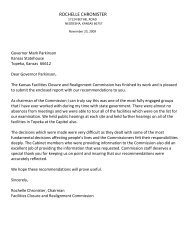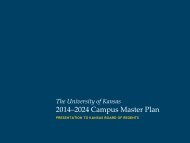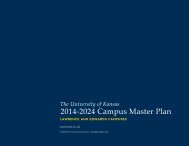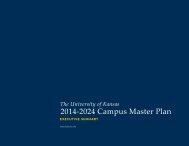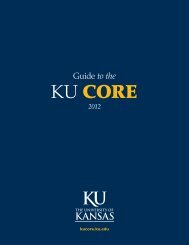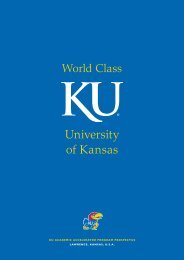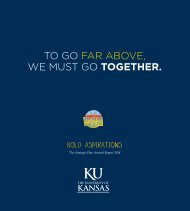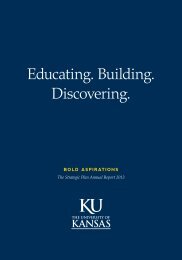KU_Chapter01_DataCollection_2014-06-10
KU_Chapter01_DataCollection_2014-06-10.pdf
KU_Chapter01_DataCollection_2014-06-10.pdf
- No tags were found...
You also want an ePaper? Increase the reach of your titles
YUMPU automatically turns print PDFs into web optimized ePapers that Google loves.
This arrangement requires large-scale movement<br />
of students between housing and academic areas<br />
throughout the course of the day. “Wescoe Beach,”<br />
a plaza outside of Wescoe Hall, is a good example,<br />
having periods of intense activity during the day<br />
and very little activity at night.<br />
Academic/research, housing, athletics, recreation,<br />
and outreach areas are generally compact land<br />
uses and individually walkable. Distances between<br />
areas and topography (slope) create challenges<br />
and some disconnects for pedestrians. The robust<br />
campus transit system efficiently moves large<br />
volumes of people, but at a cost.<br />
This land use arrangement is not atypical of other<br />
institutions, but it may be more pronounced<br />
on the Lawrence campus due to the land form.<br />
Topography is a key factor in consolidating similar<br />
land uses in order to facilitate ease of movement.<br />
Sharing resources through adjacency is clearly<br />
another important factor.<br />
Daytime activity at Wescoe Beach<br />
Outreach areas have a degree of overlap with other<br />
uses, especially in association with athletics and<br />
performing arts. These uses are defined by having<br />
both academic and event spaces serving students<br />
and the larger community. Outreach areas are<br />
well located adjacent to campus gateways.<br />
DATA COLLECTION: CAMPUS CONDITIONS<br />
42<br />
<strong>KU</strong> <strong>2014</strong>–2024 CAMPUS MASTER PLAN




